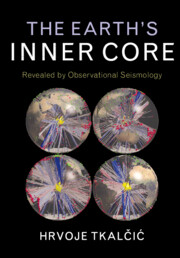Book contents
- Frontmatter
- Contents
- Preface
- Acknowledgements
- 1 On the History of Inner Core Discovery
- 2 Seismological Tools to Study the Inner Core
- 3 Inner Core Surface and Its Interior
- 4 Inner Core Anisotropy
- 5 Inner Core Rotational Dynamics
- 6 The Limitations, the Obstacles, and theWay Forward
- Appendix A Transmission/Reflection Coefficients for the Flat Inner Core Boundary
- Appendix B The Angle Between PKIKP Waves and the Rotation Axis of the Earth
- Appendix C P-Wave Velocity in a Transversely Isotropic Inner Core
- Appendix D Transdimensional Bayesian Inversion
- References
- Index
- Plate section
6 - The Limitations, the Obstacles, and theWay Forward
Published online by Cambridge University Press: 26 January 2017
- Frontmatter
- Contents
- Preface
- Acknowledgements
- 1 On the History of Inner Core Discovery
- 2 Seismological Tools to Study the Inner Core
- 3 Inner Core Surface and Its Interior
- 4 Inner Core Anisotropy
- 5 Inner Core Rotational Dynamics
- 6 The Limitations, the Obstacles, and theWay Forward
- Appendix A Transmission/Reflection Coefficients for the Flat Inner Core Boundary
- Appendix B The Angle Between PKIKP Waves and the Rotation Axis of the Earth
- Appendix C P-Wave Velocity in a Transversely Isotropic Inner Core
- Appendix D Transdimensional Bayesian Inversion
- References
- Index
- Plate section
Summary
“If you can find a path with no obstacles, it probably doesn't lead anywhere.”
AnonymousLimited Distribution of Seismic Sources and Receivers
Exploration seismologists estimate properties of the Earth's subsurface using reflecting or refracting parts of the wavefield generated by controlled sources such as dynamite, air guns, or seismic vibrators. They have control over the quantity of sources and receivers they deploy when investigating potential reservoirs of geothermal energy, coals, minerals, or hydrocarbon. In medical imaging, where the main purpose is to diagnose or treat a disease, there is a similar ‘luxury’, since the number of sources and receivers is controlled through sophisticated design. Even in helioseismology a favourable distribution of receivers can be achieved via proper experimental design, i.e. by orbiting around the Sun along a variety of paths. However, in terrestrial seismology there are fundamental reasons preventing complete volumetric sampling of the deep Earth by seismic body waves. Firstly, the majority of earthquakes large enough to be observed on the other side of the globe and utilised in IC studies occur in subduction zones within moderate latitudes. Secondly, the global distribution of seismic instruments is uneven. This is understandable given the uneven distribution of accessible landmass on the Earth's surface and the non-uniform distribution of wealth in the world. A large number of ocean bottom seismometers were installed recently; however, the recording of core-sensitive data is hampered by large amounts of noise in the 1 Hz range. The uneven distribution of events and instruments greatly limits the number of polar paths through the IC.
To illustrate how critical the lack of complete global sampling is for studies of seismic anisotropy in the IC, the angle between PKIKP waves and the rotation axis of the Earth ξ is computed for all hypothetical source-receiver pairs on the Earth's surface. Figure 6.1a helps illustrate that for a hypothetical earthquake located at the equator, the range of angles ξ that can be achieved by PKIKP waves traversing the IC to the recording stations at any given location on the Earth's surface is 70–90°. In order to achieve IC sampling by angles smaller than 30°, either the source or the receiver has to be located at latitudes beyond 60°.
- Type
- Chapter
- Information
- The Earth's Inner CoreRevealed by Observational Seismology, pp. 169 - 187Publisher: Cambridge University PressPrint publication year: 2017



